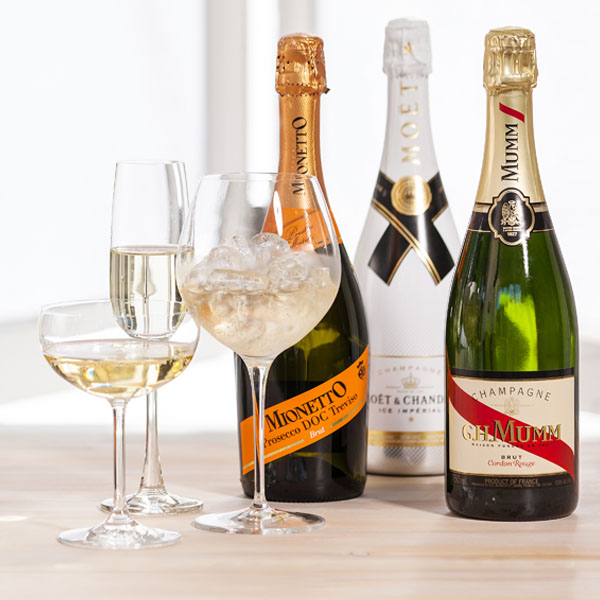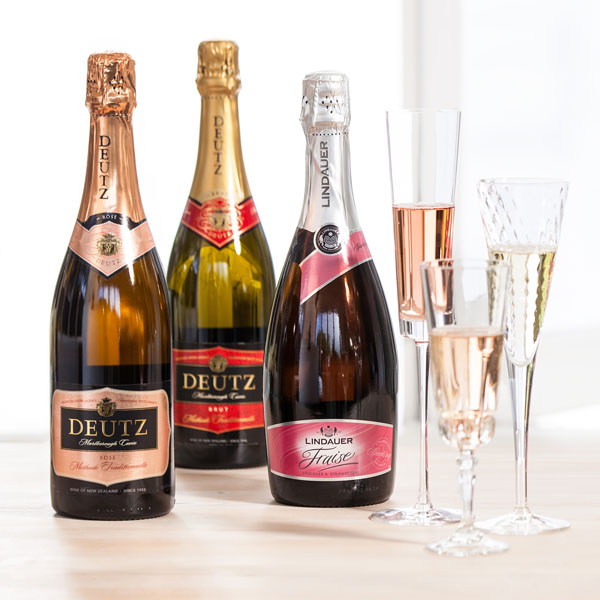Put a little fizz in your life with a closer look at some of the best sparkling wines.
No other drink sums up both the desire to celebrate and the means of celebration quite so universally as Champagne – or, to speak more generally, sparkling wine. Those dusky golden bubbles lend their effervescence to any event, occasion, or just unwinding after a tough day at the office. Most of us know a few basic facts about sparkling wine, like the fact it can only be called Champagne if the grapes are grown and the wine produced in the Champagne region in the north east of France. But to divide sparkling wine merely into the two categories of “French” and “other” is wildly underselling it, just as the words “red” and “white” ignore the incredibly varied flavour profiles and grape varieties available in still wine. So let’s take a closer look.
Wines to try
G.H.Mumm Cordon Rouge
Made with a predominance of pinot noir grapes, plenty of chardonnay and just a touch of pinot meunier, G.H. Mumm is fresh and intense with a peachy aroma,with hints of vanilla and caramel. At G.H. Mumm they are also very keen on the notion that a bottle of Cordon Rouge should be opened via sabrage – that’s with a sword. Up to you whether you want to try that at home, although it would certainly give the guests at grandma’s birthday party something to remember.
TRY IT WITH ...
seafood, but it also matches deliciously well with other white meat dishes, salad or cured meats such as ham or paté.
“Always keep a bottle of Champagne in the fridge for special occasions. Sometimes the special occasion is that you have a bottle of Champagne in the fridge.”Hester Browne
Moët Ice Imperial
And now for something completely different ... Moët Ice Impérial is the only Champagne especially created to be enjoyed over ice. The official recommended way to drink it is poured over three large ice cubes in a cabernet glass. Using large ice cubes means they’ll melt more slowly and won’t dilute that delicious Champagne too quickly. That said, it’s really up to the drinker how they like it best.
While traditional Moët, and all Champagne, is balanced to drink on its own at around that ideal temperature of 8-9°C, Moët Ice is created a little sweeter and fruitier with slightly less fizz. The ice works almost like another cocktail ingredient bringing everything into balance.
TRY IT WITH ...
a garnish of fresh mint, raspberries, limes or lychees. It also matches well with citrus flavour. Try it with a dessert of orange crème brulee or coconut and lime mousse.
Mionetto Prosecco
Prosecco is enjoying something of a boom among sparkling wine drinkers and this light, straw-coloured wine is a good example of why. Just looking at it makes you thirsty. But then, with more than 125 years practice as one of Italy’s leading producers of prosecco, you can be sure the folk at Mionetto should know what they’re doing. This is a clean, dry wine, with notes of apple and a hint of white peach. It’s a brilliant wine for matching well with a huge range of foods.
TRY IT WITH...
2 parts strawberry purée and 1 part raspberry liqueur in the bottom of your glass, topped with the Mionetto.

Deutz Marlborough Cuvée NV and Cuvée Rosé
Here at toast! we’ve often heard Deutz described as “a really great bubbly for the price”. It’s not. It’s just a really great bubbly – the price is a bonus. We think it holds its own against some of the great French Champagne houses. Although that won’t come as a surprise to those already familiar with its crisp, yeasty flavours. It’s a chardonnay predominant wine, with hints of berries and citrus with a long, satisfying after taste. And nothing tastes like spring quite so much as a classic sparkling rosé and Deutz Cuvée Rosé is our pick of the season. It’s dry, with soft berry flavours. Very more-ish, which is no bad thing.
TRY IT WITH...
This rosé is delicious as an aperitif with canapé ; try the cuvée with seafood.?
Lindauer Fraise
Infused with natural strawberry essence this is a surprisingly sophisticated wine that balances its strawberry taste and aroma with an underlying yeastiness. Sweet and fruity it tastes brilliant matched with a platter of fresh fruit and cheese.
TRY IT WITH...
a group of friends in the sun, on its own or as a base for a spring punch. Combine three cups of cold berry tea with about two litres of fruit juice, and a bottle of Fraise. Top up to taste with ginger ale then add sliced strawberries and other fruit. You could also add in a little vodka to taste.

Know your varietals
Blanc de blancs: Made from 100% chardonnay grapes, these wines are often lighter and more dry.
Blanc de noir: Made from 100% pinot noir and/or pinot meunier grapes, the wines are usually quite full-bodied and a deeper gold in colour. They’re an excellent food wine, matching particularly well with meats and cheeses.
Rosé: Sparkling rosé is produced either by leaving the clear juice of black grapes to briefly macerate on its skins to add
colour or by adding a small amount of still pinot noir red wine to the sparkling wine cuvée or juice.
Prosecco: A dry Italian sparkling wine, usually made from Glera grapes and almost always using the Charmat or tank method. The wine can only be called prosecco if it is produced in the regions of Veneto and Friuli Venezia Giulia.
Asti: is a sweeter, though still not sweet, Italian sparkling wine produced around the towns of Asti and Alba in Piedmont from the Moscato Bianco grape
Moscato d’Ast : A sweet, lower alcohol wine that is often only slightly sparkling, made in the same region from the same grapes as Asti.
What's in a name?
Champagne: The right to use the name is not governed only by location. It also covers grape growing, pruning systems, harvesting, and the method of natural fermentation in the bottle.
Methode Traditionnelle: These wines are made by exactly the same process as Champagne, but are produced out of that region. In the past they were often labelled as “methode Champenoise” but use of that term is now also restricted. These wines can be just as good as Champagne. For a start try Nautilus Cuvée Brut, champion wine of the 2013 Air NZ wine awards.
Sparkling wine: This is a generic term used to describe all bubbly, from those merely injected with carbon dioxide (probably best avoided), to Champagne and methodes.
Cellaring and Serving
Check the vintage: Non-Vintage Champagne is a blend of several different batches of wine from different years to make a more consistent product. It is produced to drink now, but will keep two to five years if the cork and storage conditions are ideal. Vintage Champagne, made when there is a great season and a vintage year is declared, can keep for five to 10 years (some say more), depending on the cork and storage. These rules also apply to all New Zealand sparkling wines fermented in the bottle.
Chill out: Chilling the wine keeps the aromatics of the bubbles, maintains bubble size and prevents frothing/ foaming, but too chilled takes away aromatics. A couple of hours in the fridge is a good guide. Alternatively leave an unopened bottle in an ice bucket filled with half ice and half water for about 30 minutes
Stop it up: How long your bubbles last depends on the wine and how much is left in the bottle – the fuller the bottle the longer it will last. A stopper in the top will help it last till the next day.
Stand tall: The best glass is still a tall, narrow flute as it preserves the bubbles, although a tulip glass, with a slightly wider tip is also ideal. There are varied opinions though, with other Champagne – and glassware – gurus saying a glass with a wider bowl such as a chardonnay glass will allow the wine to breathe. The trick to avoid losing the fizz with a wider glass is to drink it slightly faster than standing around chatting usually allows.







